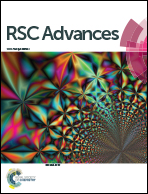A scaffold with a bio-mimetically designed micro/nano-fibrous structure using decellularized extracellular matrix†
Abstract
Decellularized extracellular matrix (d-ECM)-based scaffolds have been extensively applied in various tissue regeneration applications because they regulate various cell functions and effectively guide new tissue formation. However, fabrication methods using d-ECM have been limited by its low processability. In this study, a new fibrous scaffold consisting of poly(ε-caprolactone) (PCL) and d-ECM was fabricated using an electrohydrodynamic jet process to obtain a pore-controlled multi-layered structure. In the scaffold, the d-ECM was used as a supplementary bioactive component to induce highly active cell responses. The suggested PCL/ECM fibrous structure showed significantly higher tensility (tensile modulus: 2-fold) than a pure PCL fibrous structure with a similar pore structure. The in vitro cellular responses of the fibrous structure were increased using human fibroblasts, and the ECM-based scaffold showed significantly higher cell-seeding efficiency (1.8-fold) and metabolic activities (1.5-fold at seven days) than pure PCL with a similar pore size and porosity. These results suggest that the d-ECM-based scaffold is promising as a biomedical substrate to effectively regenerate tissues and that this fabrication method will be very useful for designing biomimetic biomedical scaffolds.


 Please wait while we load your content...
Please wait while we load your content...